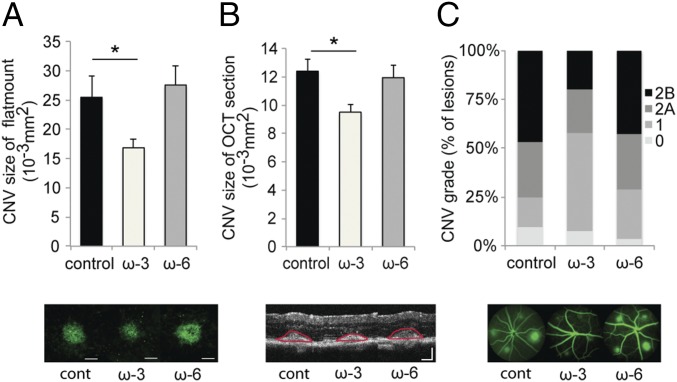Fig. 1.
Dietary intake of ω-3 LCPUFAs in Tie2-CYP2C8-Tg mice attenuates CNV. (A and B) Lesion size at 7 days (d) after CNV induction was assessed by staining of choroidal flat-mount preparations with fluorescent isolectin B4 (A), and a cross-sectional area of lesions was quantified by SD-OCT (demarcated by red lines) (B), for Tie2-CYP2C8-Tg mice fed a control diet (n = 25 lesions, respectively), ω-3 LCPUFA-enriched diet (n = 38 lesions, respectively), or ω-6 LCPUFA-enriched diet (n = 30 lesions, respectively) beginning 2 weeks (wk) before laser photocoagulation. Tie2-CYP2C8-Tg mice overexpress the monooxygenase CYP2C8 in endothelial cells, which promotes the metabolism of the primary LCPUFAs to their active downstream fatty acid metabolites. ω-3 LCPUFAs decreased CNV size in choroidal flat-mount and OCT section compared with the control diet and ω-6 LCPUFA-diet groups. Data are presented as means ± SEM. *P < 0.05. (Scale bar: 100 μm.) (C) Fluorescein leakage in CNV lesions was graded at 7 d after CNV induction in Tie2-CYP2C8-Tg mice fed a control diet (n = 25 lesions), ω-3 LCPUFA-enriched diet (n = 38 lesions), or ω-6 LCPUFA-enriched diet (n = 30 lesions) beginning 2 wk before laser photocoagulation. ω-3 LCPUFAs also attenuated fluorescein leakage from the CNV lesions compared with the control diet and ω-6 diet groups. The grade of the hyperfluorescent lesions is as follows: score 0 (i.e., no leakage); score 1 (i.e., debatable leakage); score 2A (i.e., definite leakage); score 2B (i.e., clinically significant leakage).

